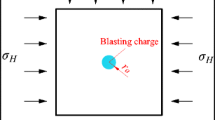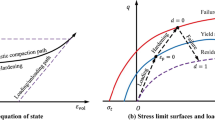Abstract
Rock breakage by chemical explosive is a complex process involving the physicalproperties of the rock mass, the detonation properties of the explosive and blastparameters. A method for model scale blasting in cement mortar blocks with dimensions 90 x80 x55 cm has been studied and the results from a single shot experiment instrumentedwith accelerometers, strain gages and pressure gages are given. Results from staticand dynamic materials testing of the cement mortar are also given. The stress time and strain time determined by the different methods are compared.
Similar content being viewed by others
References
Blair, D.P., Rise Times of Attenuated Seismic Pulses Detected in Both Empty and Fluid-Filled Cylindrical Boreholes, Geophysics, 1984, vol. 49, pp. 398–410.
Uenishi, K. andRossmanith, H.P., Part II,FragblastBalkema, Rotterdam, Pays-Bas, 1998, vol. 2, no. 1, pp. 39–77.
Ma, G.W., Hao, H., and Zhou, Y.X., Modeling of wave propagation inducted byunderground explosion, Computers and Geotechnics, 1998, vol. 22, issues 3–4, pp. 283–303.
Nicholls, H.R. and Duvall, W.I., Effect of Charge Diameter on Explosives Performance, U.S. Bureau Min., R.I 6806, 1966, p. 22.
Rustan, P., Burden, Spacing and Borehole Diameter at Rock Blasting, Proc. 3rd Int. Symp. Rock Fragmentation by Blasting, Brisbane, Australia, 1990, pp. 303–310.
Jiang, J., Blair, D.P., and Baird, G.R., Surface Vibrations due to a Buried Explosive Source, Proc. 4th Int. Symp. Rock Fragmentation by Basting, Vienna, Austria, 1993, pp. 89–96.
Fletcher, L.R., and D’Andrea, D.V., Control of Fly Rock in Blasting, Proc. 12th Conf. Expl. and Blast Technique, Konya (Ed.), Atlanta, GA,1986, pp. 167–177.
Blair, D.P. and Jiang, J., Surface Vibrations due to a Vertical Column of Explosive, Int. J. Rock Mech. Min. Sci.&Geomech. Abstr., 1995, vol. 32, pp. 149–154.
Wei-Hua Wang, 3DEC Modeling ofEffect of the Joints and Interlayer on the Wave Propagation, Int. J. Rock Mech. Min. Sci., 1998, vol. 35, issue 1, pp. 93–99.
Dowding, CH., Construction Vibrations, Prentice-Hall, Englewood Cliffs, NewJersey, 1996.
Donze, F. V., Bouchez, J.,and Magnier, S.A., Modeling Fractures in Rock Blasting, Int. J. Rock Mech. Min. Sci., 1007, vol. 34, no. 8, pp. 1153–1163.
Chongqing, W., Yong, L., and Hong, H., Numerical Prediction of Blast-Induced Stress Wave from L arge- Scale Underground Explosion, Int. J. Numerical and Analytical Methods in Geomechanics, 2003, vol. 28, issue 1, pp. 93–109.
Talhi, K., Hannachi, E.B., Hadjaj-Aoul, E., and Chabour, S., Détermination des propriétés de résistance d’un grès naturel, Annales de Chimie Science des Matériaux, 2000, vol. 25, issue 3, pp. 225–230.
Talhi, K. and Bensaker, B., Design of a Model Blasting System to Measure Peak P-Wave Stress, Soil Dynamics and Earthquake Engineering, 2003, vol. 23, issue 6, pp. 513–519.
Dobraz, B.M., LLNL Explosives Handbook, Lawrence Livermore National Laboratory, University of California, Livermore, California, USA, 1981.
Johansson, C.H. and Langefors, U., Methods of Physical Characterization of Explosives, Proc. 36th Int. Congress of Industrial Chemistry, Brussel, 1966, vol. 3, p. 610.
Holemberg, R. and Person, P.A., Design of Tunnel Perimeter Blasthole Patterns to Prevent Rock Damage, Institution of Mining and Metallurgy, London, U.K., 1979, pp. 12–16.
Stagg, K.G. and Zienkiewicz, O.C., Rock Mechanics in Engineering Practice, John Wiley and Sons, London, 1968.
Roberts, A., Geotechnology an Introductory Text for Students and Engineers, Mackay School of Mines, University of Nevada, Pergamon Press, USA, 1977, p. 182.
Asklöf, C.A. and Nylander, A., Cylindrical and Spherical Symmetric Wave Propagation in Rock, FOA2 Report C2286-44.Swedish National Defense Laboratory, Stockholm, Sweden, 1968.
Birkimer, D.L., A Possible Fracture Criterion for the Dynamic Tensile Strength of Rock in Dynamic Rock Mechanics, Proc. 12th US Symp. Rock Mechanics, 1970.
Bergmann, O.K., Riggle, J.W., and Wu, F.C., Model Rock Blasting-Effect of Explosives Properties and Other Variables on Blasting Result, J. Rock Mech. Min. Sci. &Geomench. Abstracts, 1973, vol. 10, pp. 585–612.
Koch, H.W., Zur Moglichkeit der abgrezung von Lademengen bei steinbruchspengungen nach festgestellten enschutterungsstarten, Nobel Heft 24, Seite, 1958; pp. 92–96.
Author information
Authors and Affiliations
Corresponding author
Additional information
The article is published in the original.
Rights and permissions
About this article
Cite this article
Yahyaoui, S., Hafsaoui, A., Talhi, K. et al. Method for model scale blasting. J Min Sci 51, 964–972 (2015). https://doi.org/10.1134/S1062739115050150
Received:
Published:
Issue Date:
DOI: https://doi.org/10.1134/S1062739115050150




